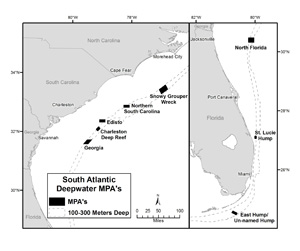NOAA Establishes Eight Marine Protected Areas to Provide Safe Havens for Deep-Water Fish
January 13, 2009
NOAA has established eight separate marine protected areas encompassing a total of 529 square nautical miles in south Atlantic federal waters to shield deep-water fish species and their habitats from fishing.

High resolution (Credit: NOAA)
All fishing for snappers, groupers, tilefishes, grunts, porgies, and sea basses is prohibited throughout the protected areas, which are located off the coast from North Carolina south to Florida.
The South Atlantic Fishery Management Council proposed the action to NOAA’s Fisheries Service as part of a larger management plan to protect these South Atlantic fish populations.
"I applaud the hard work of the council and the strong spirit of cooperative conservation among commercial and recreational fisherman to take decisive action to conserve habitat in order to sustain healthy fisheries for generations to come," said James L. Connaughton, chairman of the White House Council on Environmental Quality.
“Marine protected areas are designed to provide long-term protection for our nation’s natural resources,” said Jim Balsiger, acting NOAA assistant administrator for NOAA’s Fisheries Service. “These areas of the South Atlantic were chosen because they feature known spawning grounds and nursery habitats for deep-water fish – especially for snappers and groupers.”
The marine protected areas are critical to the survival of over 70 species of deep-water fish susceptible to fishing pressure. These fish are not good candidates for catch-and-release fishing because they suffer trauma when captured and reeled up from great depths.
In addition, some species, such as snowy grouper, can live longer than 50 years and are the most productive spawners. It is important to protect the larger fish so they can spawn to their maximum potential, and equally important to protect the younger fish so they reach maturity.
The new protected areas range in size from 21 to 150 square nautical miles. There is one area off North Carolina, three off South Carolina, one off Georgia, and three protected areas off Florida.
Commercial shark bottom longline gear is also prohibited in these areas because the deep-water fish species are likely to be caught incidentally with this gear. All other types of legal fishing, such as trolling for tunas and marlins, are allowed because those gear types are not likely to incidentally catch the species warranting protection.
NOAA understands and predicts changes in the Earth’s environment, from the depths of the ocean to the surface of the sun, and conserves and manages our coastal and marine resources.